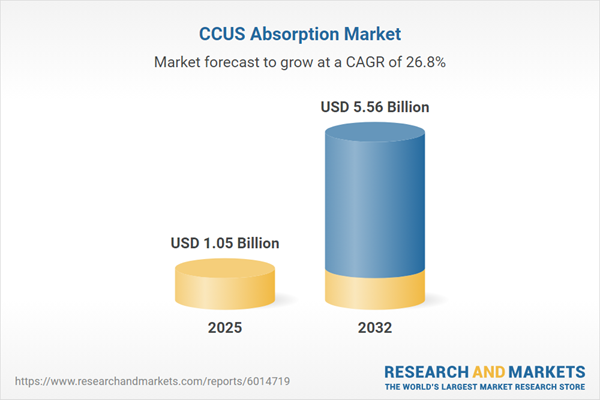Speak directly to the analyst to clarify any post sales queries you may have.
The carbon capture absorption market is emerging as a strategic solution for industries aiming to meet emissions targets and comply with changing regulations. Executive stakeholders seeking clear direction rely on up-to-date, actionable market intelligence to inform investment, partnership, and operational plans amid regulatory and technological change.
Market Snapshot: Carbon Capture Absorption Market Overview
Accelerated by strengthening environmental policy and rising sustainability commitments, the carbon capture absorption market is showing robust growth. It is currently valued at USD 830.21 million and is anticipated to reach USD 1.05 billion by 2025, expanding at a CAGR of 26.83%. This trajectory is propelled by expanding commercial adoption of advanced absorption technologies as organizations aim to enhance emissions management, drive operational resilience, and secure long-term supply chain value. Progress is closely linked to performance advancements, cross-sector alignment, and regional policy leadership, especially in areas prioritizing systematic decarbonization and resource stewardship.
Scope & Segmentation of the Carbon Capture Absorption Market
- Technology: Oxyfuel combustion and post-combustion absorption, which include both chemical and physical processes, are central in delivering customizable carbon management strategies. Pre-combustion options such as gasification and hydrogen separation extend the applicability for diverse emission contexts.
- Solvent Type: Amine-based solvents, including diethanolamine, methyl diethanolamine, monoethanolamine, and potassium carbonate, support operational adaptability, optimizing absorption performance for various industrial applications.
- End Use: The market addresses specific needs across chemical manufacturing, enhanced oil recovery, and gas processing sectors, supporting compliance and enabling ongoing supplier collaboration for targeted results.
- Industry: Segments served include cement production, oil and gas industries, coal and gas-fired power generation, and steelmaking in both blast furnace and electric arc furnace contexts, ensuring that decarbonization objectives are met for high-emission operations.
- Plant Size: Both large-scale centralized facilities and smaller modular plants are included, allowing for stable capacity at established sites and flexible deployment for emerging business models.
- Project Phase: The market spans fully operational installations, active construction projects, and facilities in the planning stage, indicating varying degrees of market maturity and readiness globally.
- Region: The Americas, Europe, Middle East and Africa, and Asia-Pacific, each with distinct policy drivers, incentive frameworks, and supply chain dynamics that shape adoption rates and long-term investment strategies.
- Key Companies: Leading market activity and innovation are driven by organizations such as Linde plc, Air Liquide S.A., Mitsubishi Heavy Industries, Honeywell UOP LLC, Shell plc, BASF SE, Fluor Corporation, Aker Solutions ASA, Carbon Clean Solutions Limited, and Carbon Engineering Ltd.
Key Takeaways for Senior Decision-Makers
- Absorption-based processes are foundational for companies navigating heightened compliance demands and competitive pressures within regulated industries.
- Modern absorption techniques offer cost-effective options for both updating legacy infrastructure and integrating into new plant construction, expanding operational versatility.
- Collaboration among technology providers, engineering groups, and asset owners accelerates timelines for deployment and strengthens alignment with best practices.
- System-wide digital monitoring and predictive analytics help improve plant availability, reduce downtime risk, and support optimal performance through informed operational decisions.
- Structured incentive frameworks and coordinated private investment are contributing to more stable supply chains and supporting consistent project delivery for sustained emissions reduction.
Tariff Impact: Supply Chain Adaptation in the Carbon Capture Absorption Market
Recent U.S. tariffs on carbon capture components have led businesses to engage more intensively with domestic and tariff-exempt suppliers. This shift is encouraging the growth of local manufacturing partnerships, reinforcing supply chain resilience and helping to maintain project schedules. Although initial cost impacts are being felt, these changes are expected to diminish uncertainty and support advancing decarbonization milestones through reliable supplier relationships.
Methodology & Data Sources
This analysis draws from primary interviews with industry figures, a comprehensive review of leading secondary materials, and systematic expert validation. Together, these approaches deliver region-specific market insights to aid informed, timely decision-making in evolving commercial and regulatory contexts.
Why This Report Matters
- Equips executive teams to drive emissions reduction with fit-for-purpose absorption technology, regardless of current facility or asset stage.
- Supports investment and technology selection choices that optimize results and foster supply chain strategies aligned with local and sector-specific needs.
- Facilitates benchmarking and partner evaluation, reinforcing collaboration and measurable progress in sustainability and operational performance.
Conclusion
Absorption technology in carbon capture is vital for operational compliance and meeting climate objectives. Ongoing innovation, dependable supply chains, and industry partnerships continue to advance large-scale industrial decarbonization.
Additional Product Information:
- Purchase of this report includes 1 year online access with quarterly updates.
- This report can be updated on request. Please contact our Customer Experience team using the Ask a Question widget on our website.
Table of Contents
3. Executive Summary
4. Market Overview
7. Cumulative Impact of Artificial Intelligence 2025
Companies Mentioned
The companies profiled in this CCUS Absorption market report include:- Linde plc
- Air Liquide S.A.
- Mitsubishi Heavy Industries, Ltd.
- Honeywell UOP LLC
- Shell plc
- BASF SE
- Fluor Corporation
- Aker Solutions ASA
- Carbon Clean Solutions Limited
- Carbon Engineering Ltd
Table Information
| Report Attribute | Details |
|---|---|
| No. of Pages | 194 |
| Published | October 2025 |
| Forecast Period | 2025 - 2032 |
| Estimated Market Value ( USD | $ 1.05 Billion |
| Forecasted Market Value ( USD | $ 5.56 Billion |
| Compound Annual Growth Rate | 26.8% |
| Regions Covered | Global |
| No. of Companies Mentioned | 11 |









